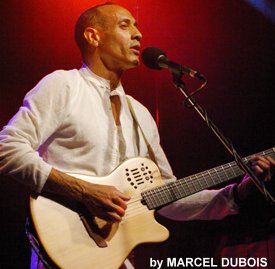Featured artist: PAULO RAMOS

The
whole world loves Brazilian music, but don’t blame it on
the bossa nova, or even on the film Black Orpheus. Even
before the classic 1959 blockbuster film about Carnival came out,
after which bossa nova hit the international air waves, there
was Antonio Carlos Jobim. As a young musician, the late composer
(1927-94) and his friends breathed new life into samba canção
(samba song), with sophisticated chord progressions and fresh
lyrics. Jobim, by the way, was also a serious composer of 12-tone
music, which probably explains the unusually sophisticated structure
of bossa nova. Today, singer-songwriter and guitarist
Paulo Ramos carries the torch for Brazilian
music in his adopted city of Montréal. And like his mentor
who was also a world traveler, Ramos has sounded the call on tour
throughout several continents.
To be
sure, the term bossa nova is a little old fashioned these days,
since it identifies the musica franca and dance craze
of the early 60s. That said, the world wouldn’t be so familiar
with Brazilian were it not for the bossa nova phenomenon started
by Jobim and company. As for Ramos, he is too versatile to be
pinned down to one style, although he rarely strays too far from
samba.
Bossa
nova, a.k.a. jazz samba, began to migrate from Brazil in the late
50s, when young college students in Rio began experimenting with
a new kind of popular music that combined the vocabulary of jazz,
convoluted chords and melodies and samba. Samba is probably Brazil’s
foremost music, which developed in Black ghettos of Rio at the
beginning of the 20th century. Though samba is most often associated
with Carnival, it is also a key component of many modern styles
of Brazilian music. Singer-guitarist João Gilberto is the
other significant originator of bossa nova, whose universally
adored, ethereal voice has almost become synonymous with the genre.
Bossa
nova is generally less percussive than samba and is highly influenced
by the tone and harmonic complexity of West Coast ‘cool
jazz.’ No surprise that Jobim’s composition, “Girl
from Ipanema,” sung by Gilberto’s wife Astrud, is
the second most played song in the United States, next to the
Beatles' “Yesterday.”
Fast
forward fifty years later, and Brazilian music continues to grow
and maintain a strong following around the world. In Montréal,
Paulo Ramos has been a fixture of the music scene for the past
twenty years. His latest recording, entitled Brasil Em Fevereiro,
finds Ramos in his element in front of a solid rhythm section
comprised of percussionist Daniel Bellegard, drummer Sacha Daoud
and bassist Dan Gigon. As well, they are joined by several guest
instrumentalists.
The quartet
swings in the very best Brazilian way – the rhythm is at
once hard driving and lilting. Ramos sings his own compositions
with a bittersweet tenderness. His instrument of choice is a solid
body acoustic guitar with nylon strings, which is an ideal solution
to a potential conflict where vocals and delicate finger work
could get short changed. The subdued tonals of an acoustic nylon-stringed
guitar are essential for Brazilian singers but the percussion
could overwhelm them.